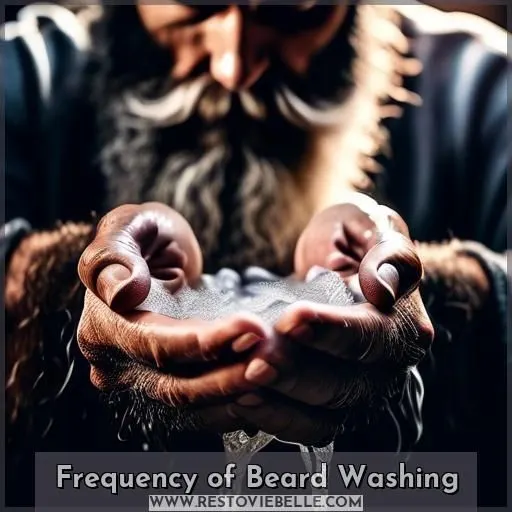This site is supported by our readers. We may earn a commission, at no cost to you, if you purchase through links.

You should wash your beard as frequently as needed, based on its type and your skin sensitivity.
Thick beards require more frequent washing to remove dirt and grime.
Thin beards need less washing to avoid tangles.
Consider your environment too – wash more often in humid or polluted areas.
Adjust frequency for sensitive skin and use gentle, natural beard washes.
After washing, always moisturize with beard oil or balm.
The right routine keeps your beard healthy and hydrated.
To truly master beard grooming, explore factors like co-washing, conditioning techniques, and common washing mistakes.
Table Of Contents
- Key Takeaways
- How Often Should I Wash My Beard?
- Understanding Beard Types
- The Role of Skin Sensitivity
- Environmental Influences on Beard Care
- Establishing a Beard Washing Routine
- The Importance of Moisturizing
- Co-Washing Explained
- Selecting Beard Wash and Conditioner
- Frequency of Beard Washing
- Beard Conditioning Techniques
- Avoiding Common Beard Washing Mistakes
- Conclusion
Key Takeaways
- Wash your beard as frequently as needed, based on its type and your skin sensitivity.
- Adjust your beard washing routine based on your environment, washing more often in humid or polluted areas.
- Identify sensitive skin and adjust your wash frequency to avoid over-drying and irritation.
- Use natural beard washes and conditioners to maintain your beard’s health and appearance.
How Often Should I Wash My Beard?
To maintain a clean and healthy beard, most men should wash it one to three times a week.
However, the frequency can vary depending on factors such as beard type, skin sensitivity, and environment**.
For example, those with thicker, fuller beards may need to wash more frequently due to increased dirt and grime accumulation.
While those with thinner beards may require less frequent washing.
Additionally, individuals with sensitive skin may need to wash less often to avoid stripping the skin of natural oils, which can lead to dryness and irritation.
It’s necessary to find a balance that works for your specific needs and beard type, as overwashing can also cause dryness and irritation.
Understanding Beard Types
Your beard’s thickness and fullness play a vital role in determining the ideal washing frequency. Thick, dense beards tend to accumulate more dirt, oil, and grime, necessitating more frequent washing, while thin or patchy beards may require less frequent cleansing to avoid over-drying the hair and skin.
Thick Vs. Thin Beards
Your beard type plays a significant role in determining your beard wash frequency.
Thick, coarse hair tends to trap more dirt and grime, so you may need to wash less frequently.
On the other hand, thin, fine hair is less prone to tangles and knots, so you might wash more often.
Always consider your skin type and the environment when establishing your beard grooming routine.
Full Vs. Patchy Beards
Essential to beard grooming is understanding the type of beard you have, whether it’s full or patchy. Here’s what you should know:
- Beard Thickness: Thick beards require more frequent cleansing to remove dirt and grime, while thin beards need less frequent cleansing to avoid tangles and knots.
- Beard Length: Longer beards may require more frequent cleansing to prevent dirt buildup.
- Beard Texture: Coarse beards may need less frequent cleansing, while fine beards may need more frequent cleansing to avoid dryness.
- Beard Grooming: Regularly use beard oil, beard balm, and beard conditioner to maintain your beard’s health and appearance.
The Role of Skin Sensitivity
You should be aware of your skin sensitivity when determining how often to wash your beard. Those with sensitive skin may need to reduce the frequency of washing to avoid over-drying and irritating the skin beneath the beard.
Identifying Sensitive Skin
Identifying sensitive skin is essential for proper beard care.
Sensitive skin can react to beard wash ingredients, causing irritation or allergic reactions.
To determine if you have sensitive skin, pay attention to the condition of your beard hair and skin.
If your beard is dry or you experience itchiness, redness, or rashes, your skin may be sensitive.
To ensure your beard care routine is suitable for your skin, try products before using them regularly.
Adjusting Wash Frequency for Sensitive Skin
If you have sensitive skin, adjusting your beard wash frequency is essential.
Overwashing can dehydrate your skin, while using harsh products can aggravate it.
Consider beard wash alternatives like natural beard cleansers and allergy-free beard care.
Seek out non-sensitizing beard washes and skin-friendly beard treatments.
Employ beard conditioner to replenish moisture and safeguard your skin.
Always adhere to the beard wash usage guidelines, and allow the beard conditioner ingredients to work their magic.
Environmental Influences on Beard Care
You’ll need to adjust your beard washing routine based on your environment.
In dry, desert climates, you can get away with washing less frequently, perhaps once or twice a week.
However, in tropical or humid regions, as well as urban areas with high pollution and dust levels, more frequent washing, up to three times per week, may be necessary.
This more frequent washing is needed to keep your beard clean and healthy.
Desert Vs. Tropical Climates
Just like your skin, your beard feels the heat or chills, adapting to climatic differences.
In arid deserts, less is more for beard care—minimize washing to retain moisture.
Conversely, tropical humidity demands a more frequent, climate-specific beard routine to fend off sweat and grime.
Seasonal beard washing tweaks, using the right beard shampoo and moisturizer, are key to maintaining ideal beard health and hygiene.
Urban Pollution and Dust
In urban environments, pollution and dust can affect your beard care routine. To maintain a clean and healthy beard, consider the following tips:
- Wash More Frequently: In dusty or polluted environments, washing your beard more often can help remove impurities and keep it clean. A twice-per-week washing routine may be sufficient in these conditions.
- Use Exfoliating Tools: Exfoliating loofahs and trimmers can help remove dirt and debris from your beard, especially in urban environments.
- Protect Your Beard: Apply a protective beard balm or oil before venturing out to shield your beard from environmental toxins.
- Carry a Comb or Brush: Keep a pocket-sized comb or brush handy to maintain beard hygiene throughout the day.
Establishing a Beard Washing Routine
You should establish a consistent beard washing routine.
It involves rinsing with lukewarm water.
Applying a gentle beard wash.
Scrubbing thoroughly with a clean rag or loofah.
Combing through the beard to remove tangles.
Patting dry with a clean towel.
This process cleanses the beard and skin without stripping away essential oils.
Laying the foundation for proper moisturization with beard oils and balms.
Rinse
Rinse your beard with lukewarm water before washing to soften the hair and open the pores.
After washing, gently scrub with a clean rag or loofah to remove any remaining dirt.
Pat your beard dry with a towel, avoiding vigorous rubbing.
If you’re co-washing, use a beard brush or comb to detangle your beard.
Wash
To properly wash your beard, start by wetting it with lukewarm water.
Then, apply a beard wash and gently massage it into your beard to create a lather.
Rinse the beard wash thoroughly and follow up with a beard conditioner if desired.
Wash at least once a week, but more often if your beard is thick, full, or exposed to dirt and dust.
Scrub
Exfoliation techniques are paramount in beard care.
The appropriate scrub can aid in removing dirt, debris, and surplus oils, while also gently removing dead skin cells beneath the beard.
Organic scrubs, such as those utilizing sugar crystals, can be efficacious for this purpose.
The frequency of exfoliation should be balanced with the skin’s requirements, as excessive exfoliation can lead to dryness and irritation.
Typically, once or twice weekly is advisable for most individuals.
When selecting a beard scrub, consider products containing beneficial ingredients such as olive fruit oil, sweet almond oil, and jojoba seed oil, which can nourish and enhance the beard.
Remember to follow the scrub with a beard wash and conditioner to ensure a thorough cleanse and maintain the well-being of your beard.
Comb
After thoroughly cleaning your beard, it’s time to address the tangles. Retrieve your reliable comb, as it’s detangling time. Bear in mind that not all combs are identical.
- Select combs specifically tailored for beards.
- Choose a comb shape that complements the density of your beard.
- Opt for a comb material that mitigates static.
- Combs with widely spaced teeth are ideal for thick beards.
- Delicate strokes minimize snagging and discomfort.
This step guarantees that your beard presents its best, setting the foundation for an impeccable finish.
Dry Off
After washing your beard, it’s crucial to dry it properly to preserve its health and appearance. Here are some suggestions on how to dry your beard:
- Blot Dry: Instead of rubbing your beard with a towel, which can cause damage and frizziness, gently blot it with a towel until it’s damp rather than soaking wet.
- Air Dry: Allow your beard to air dry until it’s about 70-80% dry before using a blow dryer. This helps prevent damage to the hair and skin.
- Use a Blow Dryer: If you’re in a hurry, you can use a blow dryer on a low heat setting, holding it about 6 inches away from your face to minimize potential harm. Use a comb to separate your beard and straighten unruly kinks while blow drying.
- Beard Oil: Apply beard oil while your beard is still slightly damp. The moisture helps absorb the hydrating properties of the oil, leaving your beard soft and manageable.
- Avoid Excessive Heat: Be cautious not to overheat your beard with the blow dryer, as excessive heat can damage the hair and skin.
The Importance of Moisturizing
You need to moisturize your beard after every wash to keep it healthy and hydrated. Beard oils and balms help condition the hair, prevent dryness and brittleness, and give your beard a well-groomed appearance. Choosing the right moisturizer depends on your beard type, skin sensitivity, and personal preference.
Beard Oils and Balms
To keep your beard healthy and well-groomed, you need to moisturize it regularly.
Beard oils and balms are essential for maintaining the health of your facial hair. Beard oil application involves rubbing a few drops of oil into your beard and massaging it into your skin.
Beard balm, on the other hand, is a solid product that you can use to style and condition your beard.
Both beard oil and balm have benefits, such as reducing beard itch, promoting healthier growing conditions, and maintaining beard hair strength.
Incorporate these products into your beard grooming habits for the best results.
Choosing the Right Moisturizer
Choosing the right moisturizer is like picking the perfect sidekick for your beard’s superhero journey. Look for moisturizing products packed with natural ingredients that promise to boost hair growth, improve beard texture, and add that coveted beard shine. It’s not just about looking good; it’s about feeling in control and safe, knowing your beard is getting exceptional care.
Co-Washing Explained
Co-washing, or washing with only a beard conditioner, is an excellent option if you have a dry beard or sensitive skin. It hydrates your beard without stripping away essential oils, providing moisture and preventing irritation.
When to Co-Wash
Co-washing, or conditioner-only washing, is a popular method for men with dry skin and thick beard hair.
It allows you to wash your beard up to 5 days a week without stripping it of its natural oils. However, if you have oily skin, you should cut back to 3 days a week.
Co-washing is beneficial for reducing dryness, softening your beard, and reducing dandruff and itchiness.
It’s a great alternative to traditional beard washing when you need to maintain a clean beard without over-drying it.
Benefits of Co-Washing
Co-washing, or conditioner-only washing, is a popular method for men with dry skin and thick beard hair.
It’s best employed up to 5 days a week for dry skin and can be reduced to 3 days a week for oily skin.
Co-washing aids in preserving beard well-being and hair growth, as it lessens dryness and itchiness without removing essential oils.
It’s crucial to select the appropriate product, such as a low-poo or no-poo conditioner, to prevent harm to your beard and skin.
Selecting Beard Wash and Conditioner
When selecting a beard wash and conditioner, avoid harsh chemicals that can strip your beard of its natural oils and leave it dry and brittle. Look for products containing natural ingredients like plant-based oils, butters, and extracts that gently cleanse while nourishing and moisturizing your beard.
Avoiding Harsh Chemicals
To maintain beard health, avoid harsh chemicals like sulfates, parabens, and synthetic fragrances. Opt for natural ingredient options. Beard wash and conditioner should be gentle and nourishing. Choose products that are free from harsh chemicals and offer a more natural, gentle approach to beard care.
Natural Ingredients
Essential to the care of your beard in its natural state is the selection of appropriate products.
Select a beard wash of natural origin, composed of organic ingredients.
Seek beard grooming products that are environmentally friendly, sustainable, and devoid of cruelty.
Not only will these choices cleanse your beard, but they’ll also nurture the skin beneath it.
Embrace the potency of nature to maintain the health and optimal appearance of your beard.
Frequency of Beard Washing
Your daily activities and beard type play a significant role in determining the ideal beard washing frequency. If you engage in activities that expose your beard to dirt, sweat, or pollutants, you may need to wash it more often. Similarly, men with thicker, denser beards tend to require more frequent washing compared to those with thinner or patchier beards.
Daily Activities and Washing
To determine the frequency of washing your beard, consider factors such as your skin type, beard length, and the environment you live in. For oily skin, washing every day or every other day can be beneficial. For dry skin, washing 2-3 times a week is recommended. If you have normal or combination skin, washing every 2-3 days can strike a balance between cleanliness and moisture retention.
Your beard length and thickness also play a role in determining the frequency of washing. Longer and thicker beards may require more frequent washing as they can trap more dirt and oils. However, be gentle with longer beards as they can be more prone to damage.
Exercise and outdoor activities can influence the frequency of washing as well. If you work out regularly or work outdoors, you may need to wash your beard more often to remove sweat and grime. In contrast, dry or cold climates may require less frequent washing as they don’t encourage much oil production.
Remember to follow up washing with a good beard oil or balm to lock in moisture and maintain beard health. Adjust your routine as needed based on your skin’s response and the specific characteristics of your beard.
Adjusting Frequency by Beard Type
Adapting your beard washing routine to your beard type is essential for keeping it healthy and looking its best. Here are four important factors to think about:
- Long beards and coarse hair might need to be washed more often, while short and thin beards mightn’t need to be washed as much.
- Dry climates and oily skin can also affect your washing schedule.
- Thick beards can collect more dirt and grime, while thin beards are less likely to get tangled and knotted.
- Always wash at least once a week, and adjust your routine based on your skin’s sensitivity and the environment.
Beard Conditioning Techniques
After washing your beard, it’s essential to apply a premium beard conditioner to restore moisture and nurture the hair follicles. Consistent conditioning not merely softens your beard and minimizes frizz, but also fortifies the hair strands, preventing breakage and facilitating healthier growth.
Applying Beard Conditioner
After washing, it’s time to condition.
Think of applying beard conditioner as laying down a smooth jazz track for your beard – it’s all about the rhythm and flow.
Choose a conditioner that sings to your beard type.
Gently massage it in, letting every strand hit the high notes.
Benefits of Regular Conditioning
- Deep conditioning: Regular beard conditioning allows for deep penetration of nourishing ingredients, providing essential hydration and moisture to both the beard and the skin beneath.
- Beard rejuvenation: Conditioning helps in softening the coarse and rough texture of the beard, making it feel softer and more manageable.
- Hair health: By using a beard conditioner, you create a favorable environment for healthy hair growth, promoting stronger and more resilient beard growth.
- Growth stimulation: Regular conditioning supports the hair follicles, which can enhance the growth of your beard by providing the necessary nutrients for healthy hair.
Remember to choose a beard conditioner that suits your skin type and beard texture, and incorporate it into your grooming routine for the best results.
Avoiding Common Beard Washing Mistakes
Overwashing your beard can strip away essential oils, leading to dryness and brittleness. Neglecting to moisturize properly after washing, or using water that’s too hot, can also damage your beard’s health and appearance.
Overwashing
Overwashing your beard can lead to skin irritation, beard breakage, scalp dryness, and product buildup.
To avoid these issues, aim for a washing frequency that suits your skin type and beard condition.
For most men, washing 1-3 times per week is sufficient.
However, adjust your washing schedule based on factors such as beard length, skin sensitivity, and environmental conditions.
Overactive oil/sweat glands may require more frequent washing, while dry beards and sensitive skin may benefit from less frequent washing.
Overwashing can also lead to a loss of beard hair due to breakage, which may be mistaken for hair loss.
To maintain beard health, focus on gentle cleanses and nourishing beard oils.
Incorrect Water Temperature
Incorrect water temperature can lead to skin irritation and damage to your beard strands.
Hot water can strip your skin and hair of protective oils, leaving them vulnerable and more prone to irritation.
On the other hand, cold water can prevent the product from penetrating the skin barrier, making it an ineffective washing session.
To avoid these issues, use lukewarm water.
Lukewarm water is gentle enough to take care of your skin and beard while ensuring an efficient and beneficial washing session.
Neglecting Moisturization
Neglecting moisturization is a common mistake in beard washing routines. Here are three ways to make sure your beard stays healthy, nourished, and protected:
- Use Beard Oil: Apply beard oil after washing to restore moisture and prevent dryness.
- Brush Regularly: Regularly brush your beard to distribute oils and reduce tangles.
- Choose Natural Ingredients: Opt for beard products with natural ingredients to avoid harsh chemicals that can damage your beard.
Conclusion
Ultimately, how often you should wash your beard depends on various factors: beard type, skin sensitivity, and environmental conditions.
By understanding these influences and establishing a personalized routine with gentle, natural products, you can maintain a healthy, hydrated beard.
Avoid common mistakes like overwashing or neglecting moisturization.
Mastering the art of beard grooming requires trial and error.
However, the rewards are a well-kept, stylish beard that complements your overall appearance.
















